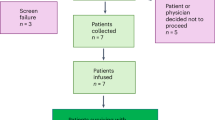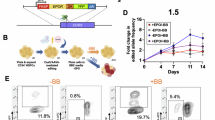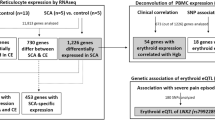Abstract
IT has been suggested that cyanate (CNO) may be useful as a therapeutic agent in the prevention of occlusive sickle cell crises1. Cyanate irreversibly carbamylates the N-terminal amino (NH2) groups of proteins and the free epsilon −NH2 groups of lysine2. Carbamylation of the terminal valine residue of sickle haemoglobin is thought to be responsible for preventing affected red blood cells (RBCs) from sickling when they are deoxygenated1. Sickle cell erythrocytes incubated with 50 mM cyanate for 90 min in vitro reportedly have an increased survival when they are radiolabelled and reinfused into the donor3. This report describes a possible side-effect of RBCs treated in vitro with sodium cyanate in similar experimental conditions: there is irreversible inactivation of the enzyme glucose-6-phosphate dehydrogenase (G6PD).
This is a preview of subscription content, access via your institution
Access options
Subscribe to this journal
Receive 51 print issues and online access
$199.00 per year
only $3.90 per issue
Buy this article
- Purchase on SpringerLink
- Instant access to full article PDF
Prices may be subject to local taxes which are calculated during checkout
Similar content being viewed by others
References
Cerami, A., and Manning, J. M., Proc. US Nat. Acad. Sci., 65, 1180 (1971).
Stark, G. R., Stein, W. H., and Moore, S., J. Biol. Chem., 235, 3177 (1960).
Gilette, P. N., Manning, J. M., and Cerami, A., Proc. US Nat. Acad. Sci., 68, 2791 (1971).
Beutler, E., Red Cell Metabolism: A Manual of Biochemical Methods, 62 (Grime and Stratton, 1971).
Berry, D. H., and Hochstein, P., Biochem. Med., 4, 317 (1970).
Cahill, G. F., Hastings, jun., A. B., Ashmore, J., and Zottu, S. J., J. Biol. Chem., 230, 125 (1958).
Szeinberg, Z., and Marks, P. A., J. Clin. Invest., 40, 914 (1961).
Srivastava, S. K., and Beutler, E., Biochem. J., 114, 833 (1969).
Stark, G. M., J. Biol. Chem., 239, 1411 (1964).
Kirkman, H. N., McCurdy, P. R., and Naiman, J. L., Human Genetics, 29, Cold Spring Harbor Symp. Quant. Biol., 391 (1964).
Sluyterman, A., Biochim. Biophys. Acta, 139, 439 (1967).
Jacob, H. S., and Jandl, J. H., J. Biol. Chem., 241, 4243 (1966).
Naylor, J., Rosenthal, I., Grossman, A., Schulman, I., and Hsia, D. Y.-Y., Pediatrics, 26, 285 (1960).
Yoshida, A., Stamatoyannopoulos, G., and Motulsky, A. G., Science, 155, 97 (1967).
Author information
Authors and Affiliations
Rights and permissions
About this article
Cite this article
GLADER, B., CONRAD, M. Cyanate Inhibition of Erythrocyte Glucose-6-phosphate Dehydrogenase. Nature 237, 336–338 (1972). https://doi.org/10.1038/237336a0
Received:
Revised:
Issue date:
DOI: https://doi.org/10.1038/237336a0
This article is cited by
-
An evolutionary theory of cuisine
Human Nature (1990)



